

Can’t sleep? Turn the lights off earlier. Can’t fall asleep?

You may need to turn the lights off earlier. Studies show exposure to light after dusk, particularly light from computer screens, iPads, iPhones, televisions, and other electronic items, significantly inhibits the production of melatonin, your body’s sleep hormone. Insomnia is a national problem, affecting about 30 percent of Americans and fueling a $2 billion sleep medication industry. Although prescription sleep medications are common, they also come with troubling side effects and a four times higher risk of death. While the natural sleep aid melatonin may be safer, it can disrupt your body’s delicate balance of hormones and create a dependency.
The best natural sleep aid may be to change your lighting after dusk. Computer Devices Could Be Stealing Your Sleep. CBS Chicago (con't) Affordable Care Act Updates: CBSChicago.com/ACA Health News & Information: CBSChicago.com/Health CHICAGO (CBS) — How many times did you yawn today?
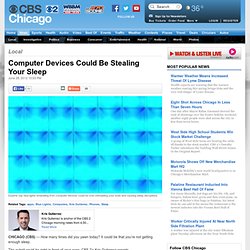
It could be that you’re not getting enough sleep. The culprit could be right in front of your eyes, CBS 2’s Kris Gutierrez reports. Melatonin. Melatonin Many biological effects of melatonin are produced through activation of melatonin receptors,[5] while others are due to its role as a pervasive and powerful antioxidant,[6] with a particular role in the protection of nuclear and mitochondrial DNA.[7] The full effects of long-term exogenous supplementation in humans have not yet been ascertained.[8] Melatonin is categorized by the US Food and Drug Administration (FDA) as a dietary supplement and is not regulated as a pharmaceutical drug.[9] A prescription-only, timed release melatonin product for people aged 55 and over was approved for use by the European Medicines Agency in 2007, despite having shown only small effects,[10] and in Australia in 2009.[11] Plants[edit]
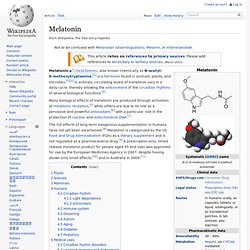
Light Therapy Edges Out Prozac In Head-To-Head Comparison. In a head-to-head comparison between the antidepressant Prozac (fluoxetine) and light therapy, the light therapy came out on top.
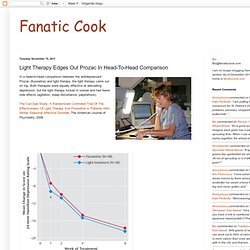
Both therapies were equally effective at alleviating depression, but the light therapy kicked in sooner and had fewer side effects (agitation, sleep disturbance, palpitations): The Can-Sad Study: A Randomized Controlled Trial Of The Effectiveness Of Light Therapy And Fluoxetine In Patients With Winter Seasonal Affective Disorder, The American Journal of Psychiatry, 2006. F.lux: sleep research. Trouble sleeping?

If you have sleep trouble or you're trying to learn more about sleep in general, we recommend understandingsleep.org. Study: Reading on a tablet vs. book In 2014, a new study was published in PNAS (full text) that compares the effects of reading an iPad before bed, versus a regular paper book. AMA Report. Lighting Research Center. Researchers Use Blue Light to Treat Sleep Disturbances in the Elderly Seniors receive the experimental light treatment while playing cards in the residence dining room.

In a recent pilot study, scientists at the Lighting Research Center demonstrated how exposure to blue light can reduce sleep disturbances and increase the likelihood of stable, consolidated sleep in seniors. The study included subjects with Alzheimer’s disease , an illness often accompanied by severely irregular sleep/wake patterns, as well as those without dementia who simply have trouble sleeping. The occurrence of sleep disturbances increases as we age. Csaph4-A-12 - a12-csaph4-lightpollution-summary.pdf.
Tjp0526-0695.pdf. Sleep and Health Education Program. The effect of high correlated colour temperature office lighting on employee wellbeing and work performance. A prospective, controlled intervention was conducted involving study participants working as call-handlers on two floors of the offices of Standard Life Healthcare (SLH) in Stockport, UK.
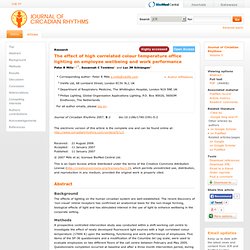
SLH is a shift-working call centre with long working days spanning 8 am–8 pm, divided into early and late shifts. The two floors used for the study are identical in their layout and operational function within the organisation. Each floor is equipped with 600 mm square recessed luminaries with aluminium louver (4 × 6 cells) and four 18 W fluorescent tubes.
The luminaire spacing is 2.4 m × 2.4 m. Each work area has dark floors and white walls. At baseline both floors were illuminated with lights with a correlated colour temperature of 2900 K. Figure 1. Before the lamp change, horizontal and vertical illluminance values were determined on more than 10 desks from each floor, deemed representative of the range of working conditions. Data collection Over the last 3 days how much have you been bothered by: F.lux: software to make your life better. Night Lighting – Protecting your hormones. One Color Night Light Is Best For Sleep - But The Color Will Surprise You. If you have to have light at night, a new study suggests that the color can make a big difference in how (un)healthy it is - and the answer is counter-intuitive.
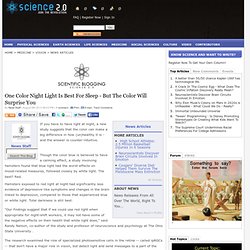
Though the color blue is believed to have a calming effect, a study involving hamsters found that blue light had the worst effects on mood-related measures, followed closely by white light. The best? Red. Red Light for a Healthy Night's Sleep. One fine Friday about a year ago, I made a purchase that I had been aching to make for years, but had been unable to, because the product I coveted was not yet on the market.
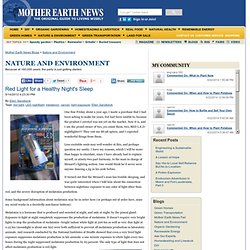
Now it is, and I am the proud owner of two, yes count them, two, RED L.E.D. nightlights!!!! They cost me $6.98 apiece, and I expected wonderful things from them. Light Spectrum. Preliminary evidence that both blue and red light can induce alertness at night. Since the a priori hypothesis was that the circadian system mediated light-induced nocturnal alertness, the experiment was designed so that the two levels of red light exposure would serve as controls for the two levels of blue light exposure.
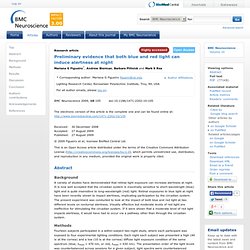
Initially then, a pair of repeated measures ANOVAs (two [light spectra] by two [light levels] by four [channels]) was performed, one using the percent power in the EEG recordings for the alpha frequency range (8-12 Hz) and the other using the percent power for the beta frequency range (12-30 Hz), as recorded from four scalp electrode channels (Oz, Pz, Cz and Fz). There was no significant main effect of light spectra (F1,13 = 0.005, ns, and F1,13 = 1.09, ns, for alpha and beta power, respectively) or of light levels (F1,13 = 0.03, ns, for both measures), nor was the interaction between these independent variables statistically significant for either dependent variable (F1,13= 3.27, ns, and F1,13 = 3.65, ns, for alpha and beta, respectively).
Blue Light To Stay Awake, Red Light To Sleep. One of the tests coming up in the International Space Station is the use of various wavelengths of light to stimulate wakefulness and sleep: Light therapy, Lighting. How light therapy can help Artificial lighting means we can make our days last as long as we want. Caught up in the fast pace of modern life, often people’s days spill over into their evenings causing them to delay bedtime and sacrificing their sleep. Not getting enough rest has an impact on how we function in our day-to-day lives. Often it’s only during the weekend that we can catch up on our sleep. Reducing the amount of light during the few hours running up to bedtime, along with exposure to natural light early in the morning, can both help getting to sleep at the right time. It’s possible to achieve a good balance between resting and being active by maintaining a regular lifestyle without too much variation in bedtimes.
Philips hue. Tunable light bulbs could help you sleep better - tech - 16 November 2012. A new generation of colour-changing LED light bulbs may help you relax, concentrate, or even improve your sleep habits. Philips 431643 Hue Personal Wireless Lighting, Starter Pack, Frustration Free: Home Improvement. Philips 431650 Hue Personal Wireless Lighting, Single Bulb, Frustration Free - Amazon.com. F.lux: software to make your life better. F.lux for iPhone, iPad, and iPod touch. F.lux for iPhone, iPad, and iPod touch September 30, 2011 f.lux is now available for jailbroken iOS devices.
To install f.lux on your iPhone, iPad, or iPod touch, you'll need to jailbreak your device. Jailbreaking automatically installs Cydia, which is an alternative way to install software on your iOS device, like the App Store, but for software other than Apps. For more details and technical information about f.lux for iOS, please check out our Cydia page. If my device is already jailbroken, how do I install f.lux? Open Cydia on your device:Search for f.lux. Living Colors Aura White One Light Table Lamp Philips Specialty Table Lamps Lamps.
Block out blue light for better sleep. Uvex Skypers are protective eyewear that have built-in side shields and a brow guard. Lightweight and comfortably snug, they fit me perfectly out of the box, but they do come with a nose bridge and an adjustable temple length for those who need to customize the fit. With great eye coverage and total comfort, I’m sure they fit the bill when it comes to safety glasses, but that’s not why I use them. With interchangeable lenses that come in an array of colors, I’ve finally found the missing ingredient that completes my nighttime recipe to combat insomnia: the Extreme Orange Anti Fog lenses! For years I’ve had chronic insomnia, and have tried everything from herbal teas to hot baths to the occasional prescription. These things would help for a night or two, and then the insomnia would come back like a tenacious weed.